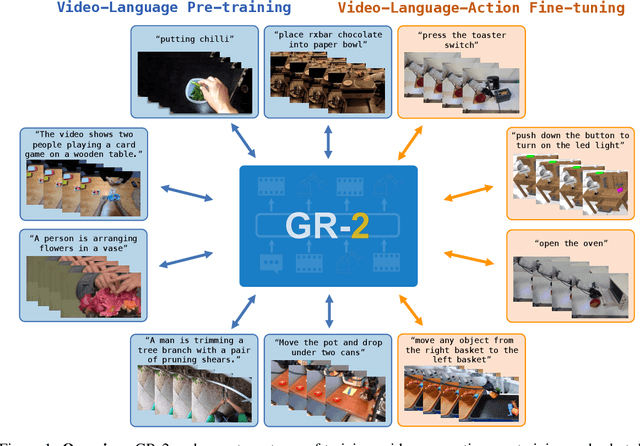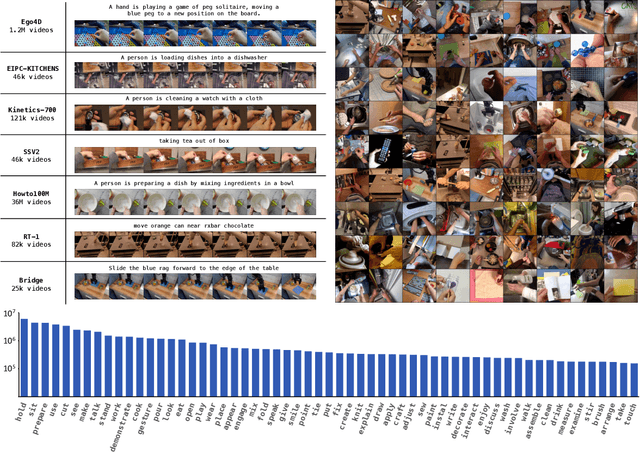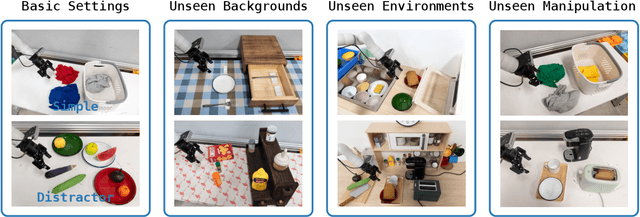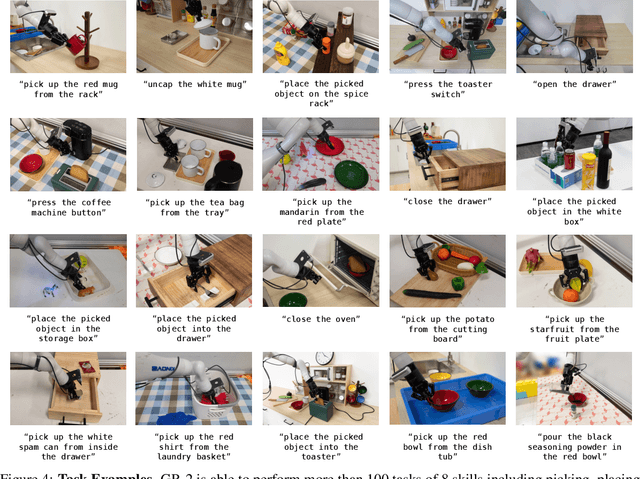Guangzeng Chen
GR-2: A Generative Video-Language-Action Model with Web-Scale Knowledge for Robot Manipulation
Oct 08, 2024



Abstract:We present GR-2, a state-of-the-art generalist robot agent for versatile and generalizable robot manipulation. GR-2 is first pre-trained on a vast number of Internet videos to capture the dynamics of the world. This large-scale pre-training, involving 38 million video clips and over 50 billion tokens, equips GR-2 with the ability to generalize across a wide range of robotic tasks and environments during subsequent policy learning. Following this, GR-2 is fine-tuned for both video generation and action prediction using robot trajectories. It exhibits impressive multi-task learning capabilities, achieving an average success rate of 97.7% across more than 100 tasks. Moreover, GR-2 demonstrates exceptional generalization to new, previously unseen scenarios, including novel backgrounds, environments, objects, and tasks. Notably, GR-2 scales effectively with model size, underscoring its potential for continued growth and application. Project page: \url{https://gr2-manipulation.github.io}.
Unleashing Large-Scale Video Generative Pre-training for Visual Robot Manipulation
Dec 21, 2023



Abstract:Generative pre-trained models have demonstrated remarkable effectiveness in language and vision domains by learning useful representations. In this paper, we extend the scope of this effectiveness by showing that visual robot manipulation can significantly benefit from large-scale video generative pre-training. We introduce GR-1, a straightforward GPT-style model designed for multi-task language-conditioned visual robot manipulation. GR-1 takes as inputs a language instruction, a sequence of observation images, and a sequence of robot states. It predicts robot actions as well as future images in an end-to-end manner. Thanks to a flexible design, GR-1 can be seamlessly finetuned on robot data after pre-trained on a large-scale video dataset. We perform extensive experiments on the challenging CALVIN benchmark and a real robot. On CALVIN benchmark, our method outperforms state-of-the-art baseline methods and improves the success rate from 88.9% to 94.9%. In the setting of zero-shot unseen scene generalization, GR-1 improves the success rate from 53.3% to 85.4%. In real robot experiments, GR-1 also outperforms baseline methods and shows strong potentials in generalization to unseen scenes and objects. We provide inaugural evidence that a unified GPT-style transformer, augmented with large-scale video generative pre-training, exhibits remarkable generalization to multi-task visual robot manipulation. Project page: https://GR1-Manipulation.github.io
MOMA-Force: Visual-Force Imitation for Real-World Mobile Manipulation
Aug 07, 2023



Abstract:In this paper, we present a novel method for mobile manipulators to perform multiple contact-rich manipulation tasks. While learning-based methods have the potential to generate actions in an end-to-end manner, they often suffer from insufficient action accuracy and robustness against noise. On the other hand, classical control-based methods can enhance system robustness, but at the cost of extensive parameter tuning. To address these challenges, we present MOMA-Force, a visual-force imitation method that seamlessly combines representation learning for perception, imitation learning for complex motion generation, and admittance whole-body control for system robustness and controllability. MOMA-Force enables a mobile manipulator to learn multiple complex contact-rich tasks with high success rates and small contact forces. In a real household setting, our method outperforms baseline methods in terms of task success rates. Moreover, our method achieves smaller contact forces and smaller force variances compared to baseline methods without force imitation. Overall, we offer a promising approach for efficient and robust mobile manipulation in the real world. Videos and more details can be found on \url{https://visual-force-imitation.github.io}
 Add to Chrome
Add to Chrome Add to Firefox
Add to Firefox Add to Edge
Add to Edge